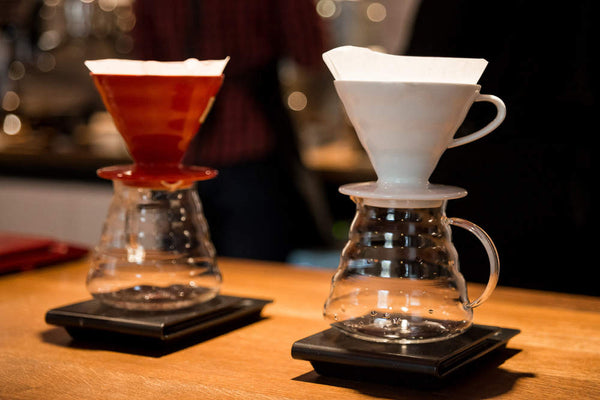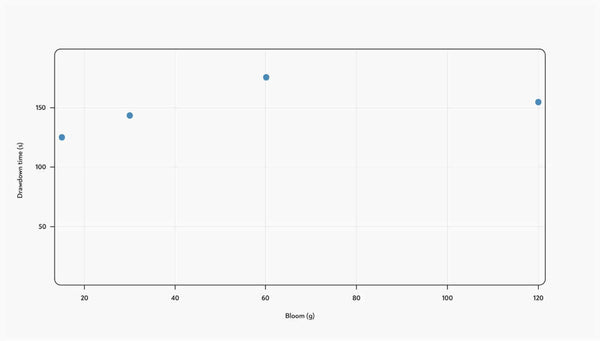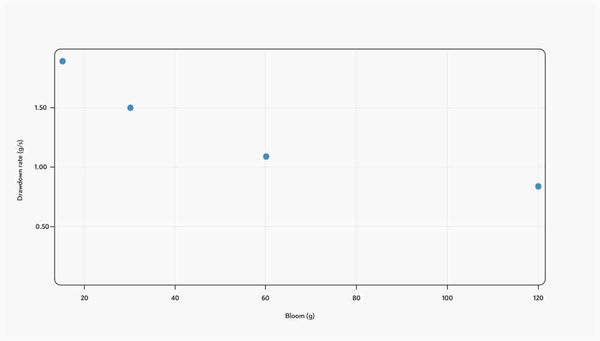Finding out how much water to use for pre-wetting the coffee filter
The pre-wetting process is an essential step in preparing a delicious cup of coffee. During this stage, gas residues are removed from the ground beans that can otherwise affect the quality of your beverage's flavor. Pre-wetting helps ensure you get the best and most flavorful extraction results possible.
When it comes to pre-wetting ground coffee, there is no consensus among experts about the amount of water needed. Some contend that 2g per 1g of grounds should be sufficient, while others suggest a higher ratio of 3g or 4g - as proposed by Matt Perger from Barista Hustle.

Experiment: how the amount of water affects the flow rate and TDS
To understand how the amount of pre-wetting water affects the brewing process and outcome, the Barista Hustle team conducted an experiments.
To prepare our freshly brewed cups of coffee using the V60 funnel, we used 15 grams of ground coffee and 250 milliliters of water each time. We took some water for pre-wetting from the total amount which altered the ratio slightly. Subsequently, we added a small portion of this pre-wetted water to our grounds and stirred them with an NSEW (North South East West) motion - evenly distributing it throughout starting at one end and working to the other.
After 30 seconds of prewetting, the remaining water was added in a steady circular motion to evenly coat the coffee. Both during the pre-wetting and infusion stages, the same pouring speed and height were maintained consistently.
Throughout the experiment, we tracked both the amount of time that elapsed as well as the Total Dissolved Solids (TDS) in each beverage produced.
We observed that as the ratio of pre-wetting water to ground coffee increased (from 1:1 to 4:1), so too did its infusion time. The longest duration was noted when using 60 g of water; however, this decreased drastically upon introducing 120 g - eight times more than the original amount - for pre-wetting purposes.

By introducing 60g of water, we can drastically reduce the flow time in comparison to the ratio of prewetting and total time. The addition of water leads to a decrease in flow time.
Subsequently, when there was 8 times more water used for pre-wetting, the time of the strait decreased. Thus, researchers proposed that this should cause an increase in speed. To assess their hypothesis, they estimated the mean velocity of the strait by recording how much water was infused throughout a specific brewing period (not including pre-wetting). Surprisingly though, increasing the amount of liquid resulted in slower pacing - suggesting paper filter clogging as a probable factor.

As the amount of water for prewetting increases, the average speed in a strait decreases. This is evidenced by our research data on this ratio.
After examining the TDS of various beverages, researchers discovered that a greater amount of water added to prewet produced higher extractions. Though not conclusively established, there is speculation that this could be attributed to an increase in volume rather than increased contact time due to reduced flow rate.
Our experiment revealed that the higher the level of water prewetting, the greater amount of extraction. Nevertheless, at increased levels of water usage, we also noted a reduced rate in speed through strait sections - likely caused by small particles obstructing pores within filter paper. This risks developing channels as well as an irregular extraction process for ground coffee beans. Undoubtedly, our findings demonstrate how prewetting affects filter papers significantly!
How Prewetting Affects Filter Paper
The Barista Hustle team sought to understand why more prewetting water had such a tremendous impact on the number of fine particles that clogged the filter. Three assumptions were formulated. Perhaps, it is in an abundance of water that small coffee grounds are most active and settles onto the filter while stirring during prewetting, thus implying that maybe it's the sheer volume of liquid which dictates how many minuscule grains will find their place within the paper-filter pores.
Creating more contact areas between the water and filter surface during pre-wetting can result in a greater number of fine particles settling on the larger filter area. The flow of water helps to saturate the coffee, causing it to swell, yet some of this liquid passes through small particles as well. To determine precisely what happens here requires further experimentation without stirring, which has not been conducted as yet.
What is the result
To make a delectable cup, you need to determine the precise amount of water for pre-wetting. If too little is used, patches of undissolved coffee grounds will remain in your brew which can cause an uneven extraction disharmonization its flavor.
- If too much water is used, small particles of coffee can clog the paper filter, causing channels to form.
- It is recommended to take 2-3 g of water per 1 g of ground coffee. Choose your optimal ratio, taking into account the model of the coffee grinder, the brewing method, and the type of coffee.

